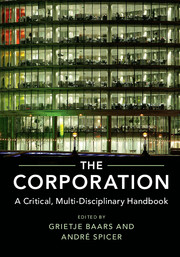Book contents
- Frontmatter
- Contents
- List of Contributors
- Acknowledgements
- Introduction: Why the Corporation?
- PART I DISCIPLINARY OVERVIEWS
- PART II INTERDISCIPLINARY THEMATIC CHAPTERS
- 1 The Evolution of the Corporate Form
- 2 The Multinational Corporate Group
- 3 The Financialization of the Corporation
- 4 Corporate Value Chains
- a The Nature of the Firm in Global Value Chains
- b The Corporation and the Global Value Chain
- c Global Production Networks and the Changing Corporation
- 5 Corporate Citizenship
- 6 The Corporation and Crime
- 7 The Corporation and Ideology
- 8 Corporation and Communities
- 9 Corporations and Resistance
- 10 Alternatives to the Corporation
- Index
- References
b - The Corporation and the Global Value Chain
from 4 - Corporate Value Chains
Published online by Cambridge University Press: 31 March 2017
- Frontmatter
- Contents
- List of Contributors
- Acknowledgements
- Introduction: Why the Corporation?
- PART I DISCIPLINARY OVERVIEWS
- PART II INTERDISCIPLINARY THEMATIC CHAPTERS
- 1 The Evolution of the Corporate Form
- 2 The Multinational Corporate Group
- 3 The Financialization of the Corporation
- 4 Corporate Value Chains
- a The Nature of the Firm in Global Value Chains
- b The Corporation and the Global Value Chain
- c Global Production Networks and the Changing Corporation
- 5 Corporate Citizenship
- 6 The Corporation and Crime
- 7 The Corporation and Ideology
- 8 Corporation and Communities
- 9 Corporations and Resistance
- 10 Alternatives to the Corporation
- Index
- References
Summary
The global value chain is nearly ubiquitous in contemporary discussions of trade and development. Government officials and industry leaders tout the importance of participating in global value chains (GVCs) as a prerequisite for generating investment, fostering technological innovation and creating employment. Calls for trade liberalization and other reforms are buttressed by the argument that such measures will not only increase a country's general competitiveness, but specifically that they will facilitate incorporation into GVCs that ‘put firms and economies on potentially dynamic learning curves’ (Gereffi, 1999: 39). Diverse institutional actors, including the Organization for Economic Co-operation and Development (OECD), the United Nations Conference on Trade and Development, and the World Trade Organization (WTO), are promoting a view of GVCs as opportunity structures that developing countries need to tap in order to capture the gains from globalization (Nielsen, 2014; Werner et al., 2014). As the ‘face of the modern global economy’, GVCs are said to be inaugurating nothing less than ‘a new world of trade’ (Lamy, 2014a).
This chapter focuses on what global value chains imply about the corporation and its role in the world economy. The discussion unfolds in three sections. First, I examine how the concept of the value chain is being used to explain changes in the organization of global production, and the role of the corporation in orchestrating these changes. Second, I narrow in on governance as the key theoretical dimension that GVC scholars have developed to explain how corporate power is exercised through value chains. Third, I consider what different governance dynamics imply about the prospects for regulating corporate power in a global economy.
Global Value Chains and the ‘New World of Trade’
The academic origins and antecedents of the GVC construct are multiple (Bair, 2008). These include the global commodity chain framework popularized by Gary Gereffi (1994; 1999; also Hopkins and Wallerstein, 1977), the broader supply chain management literature (Laseter and Oliver, 2003), Michael Porter's (1985) concept of the value system, and work on global production networks in economic geography (Coe et al., 2008) and critical management studies (Levy, 2008).
- Type
- Chapter
- Information
- The CorporationA Critical, Multi-Disciplinary Handbook, pp. 326 - 335Publisher: Cambridge University PressPrint publication year: 2017
References
- 1
- Cited by



